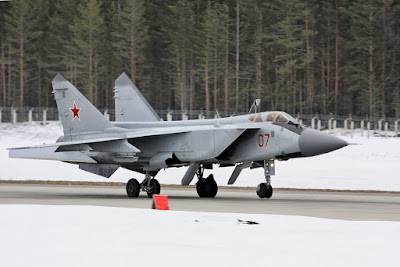The Syrian government has received six MiG-31 'Foxhound' interceptor aircraft from Russia under a deal that was said to have been signed in 2007, a regional media source has reported.
Syria was reported to have ordered eight MiG-31 combat aircraft as part of a wider defence deal with Russia in 2007. Although this deal was confirmed at the time by the head of the United Aircraft Corporation (UAC), Alexei Fyodorov, it was later denied by Anatoly Isaykin, director of state arms export bureau Rosoboronexport, who in 2010 described the sale as "a journalistic hoax". Neither the Russian nor the Syrian authorities have so far commented publicly on the reported deliveries.
The MiG-31 first entered Soviet service in the early 1980s as a long-range, high-altitude, and high-speed interceptor. Although relatively old, it is still a highly capable platform that features some of the latest sensor and weapons fits.
 |
| Mikoyan MiG-31 Fighter |
In particular, the MiG-31's NIIP N007 S-800 SBI-16 (RP-31) Zaslon or Zaslon-A electronically scanned phased-array fire-control radar (NATO codename 'Flash Dance') affords it an impressive beyond-visual range capability, enabling it to see airborne targets out to a range of 108 n miles (200 km; 124 miles) in a clutter-free forward sector, or 48 n miles (90 km; 56 miles) to the rear. It is capable of tracking 10 targets and attacking four simultaneously. Coupled with this radar, the MiG-31's R-33 (NATO codename AA-9 'Amos') or R-37 (AA-X-13/AA-13 'Arrow') long-range air-to-air missiles afford it a highly potent beyond-visual range (BVR) air-to-air capability.
Russia has approximately 200 MiG-31s in service that it is currently in the process of upgrading to keep them operational through to the 2030s. With the exception of Russia and now possibly Syria, only Kazakhstan flies the type.




No comments:
Post a Comment